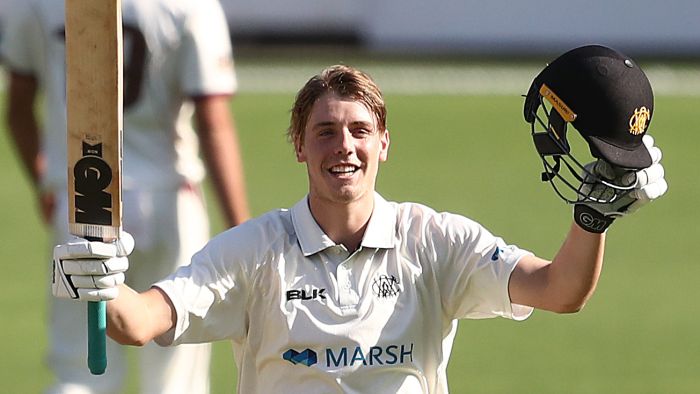In his various roles as selector, batting coach and national talent manager, Greg Chappell has been both a well-respected and also occasionally contentious figure in Australian cricket.
To some, Chappell is the restless mind whose endless search for perfection sorts the wheat from the chaff, thus creating early opportunities for the most talented young players.
“Talent is like fruit,” Chappell once said of his selection philosophy.
“If you don’t pick it at the right time it goes rotten.”
To others, Chappell’s infatuation with youth led to the destruction of the state second XI competition in favour of an under-age model, which limited the prospects of late-blooming players and compromised the standard of the Sheffield Shield.
But however you see him, Chappell has been like the pig in the proverbial manure inside the Sheffield Shield’s Adelaide hub, where it seemed the future of Australian batting was unfolding before his eyes.
Cameron Green’s 197 for Western Australia against New South Wales last month prompted Chappell to make the seemingly outlandish claim the 21-year-old was the best home-grown batsman since Ricky Ponting, and to insist he should be selected for the first Test against India next month.
Then Chappell made a timely appearance in the commentary box as 22-year-old Victorian Will Pucovski compiled 255 not out against South Australia, the bulk of it during a Sheffield Shield record partnership of 486 with Marcus Harris.

Such is our infatuation with youth, Harris got about as much recognition as the sight screen, despite matching Pucovski run-for-run in a performance that might normally have seen the older Victorian’s chance of a Test recall enhanced.
Pucovski’s tale includes a couple of seasons spent battling the debilitating impact of repeated concussions that caused him to take a break from the game.
Yet it was as much Pucovski’s relative youth as his back story that made him seem more beguiling than Harris, who is himself just 28 and in his cricketing prime.
“I have been accused of being obsessed with youth,” said Chappell when quizzed by a fellow commentator about his predilection for promoting young players.
“I’m just obsessed with talent.”
Chappell was just 22 when he made a Test century on debut against England in Perth in 1970.
His older brother Ian was 21 when he played his first Test against Pakistan at the MCG in 1964.
For these scions of a famous cricketing family, any remaining rough edges were mostly smoothed in the fierce combat of Test cricket. So it would be understandable if they were to wonder why any batsman worthy of the international arena was not already playing for Australia in their early 20s.




But if Greg Chappell’s view is skewed by his own rare gifts, I suspect the general public obsession with promoting youth is based on the acknowledgement that batting is one of the most mentally challenging pursuits in all of sport.
So when we see Green and Pucovski handing top-flight bowling with such nonchalance at an age well before most have gained the necessary wiles and wisdom, we see superheros; batsmen whose natural gifts defy the more mundane factors such as sheer hard graft.
It is often only after such a rare talent is fulfilled that we find seeing is not always believing. We discover that, to use one famous example, Ponting had taken more throw downs at 14 than most fellow players will in a lifetime.
School of hard knocks has value
Despite Chappell’s youth-oriented adjustments to the Test pathway, the more recent history of Australian cricket favours the game’s batting tortoises over its young hares.
The successful late-life Test career of Chris Rogers, now coach of Victoria, was both heart warming and also a warning of the folly of discarding those batsmen whose resilience is forged over long years in the first-class system here and abroad.
It is also worth remembering even Australia’s most audacious batting talents Steve Smith and Dave Warner had to defy early stereotypes. Smith worked his way from specialist leg spinner to world-class top order batsman and Warner overcoming the misconception he was “only a limited overs player”.
In that regard, the return of 33-year-old Moises Henriques to Australia’s one-day squad might be considered a reassuring sign of the open mindedness of the current selectors regardless of whether they give an early opportunity to Green and Pucovski this summer.
It is also worth considering the strike rate of those rare prospects who have been handed an early Baggy Green. When the 20-year-old Matt Renshaw saw off the South African pace attack under the Adelaide lights in 2016, we searched his Yorkshire heritage for genealogical links with Sir Geoffrey Boycott.
Four years later Renshaw is making his way as BBL dasher and part-time spinner, struggling to hold his place in the Queensland Sheffield Shield team and seemingly some way from earning the kind of Test resurrection another Queensland opener, Matthew Hayden, famously enjoyed.




Meanwhile, the encouraging early performances of Green and Pucovski have at the very least created an old-fashioned bar room selection debate ahead of the series against India.
Is Matthew Wade discarded for Green, who can also bowl lively spells?
Is Pucovski a better long-term partner for Warner than Joe Burns despite the Queenslander’s recent success?
The answer will divide those bedazzled by the promise of youth and with greater respect for the game’s school of hard knocks, although there are no prizes for guessing what Greg Chappell thinks.







